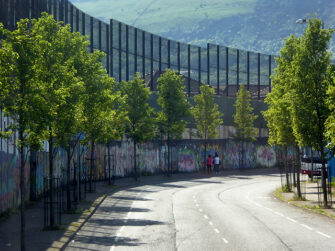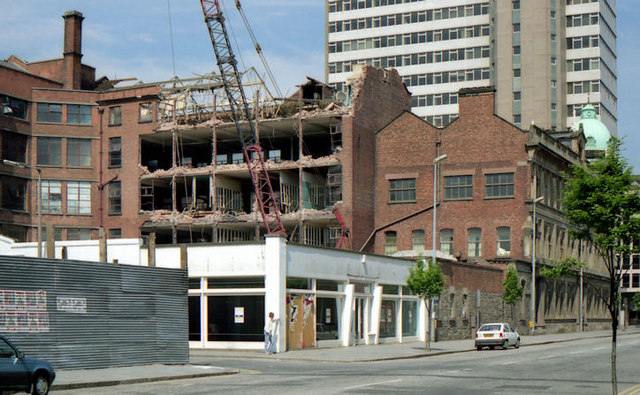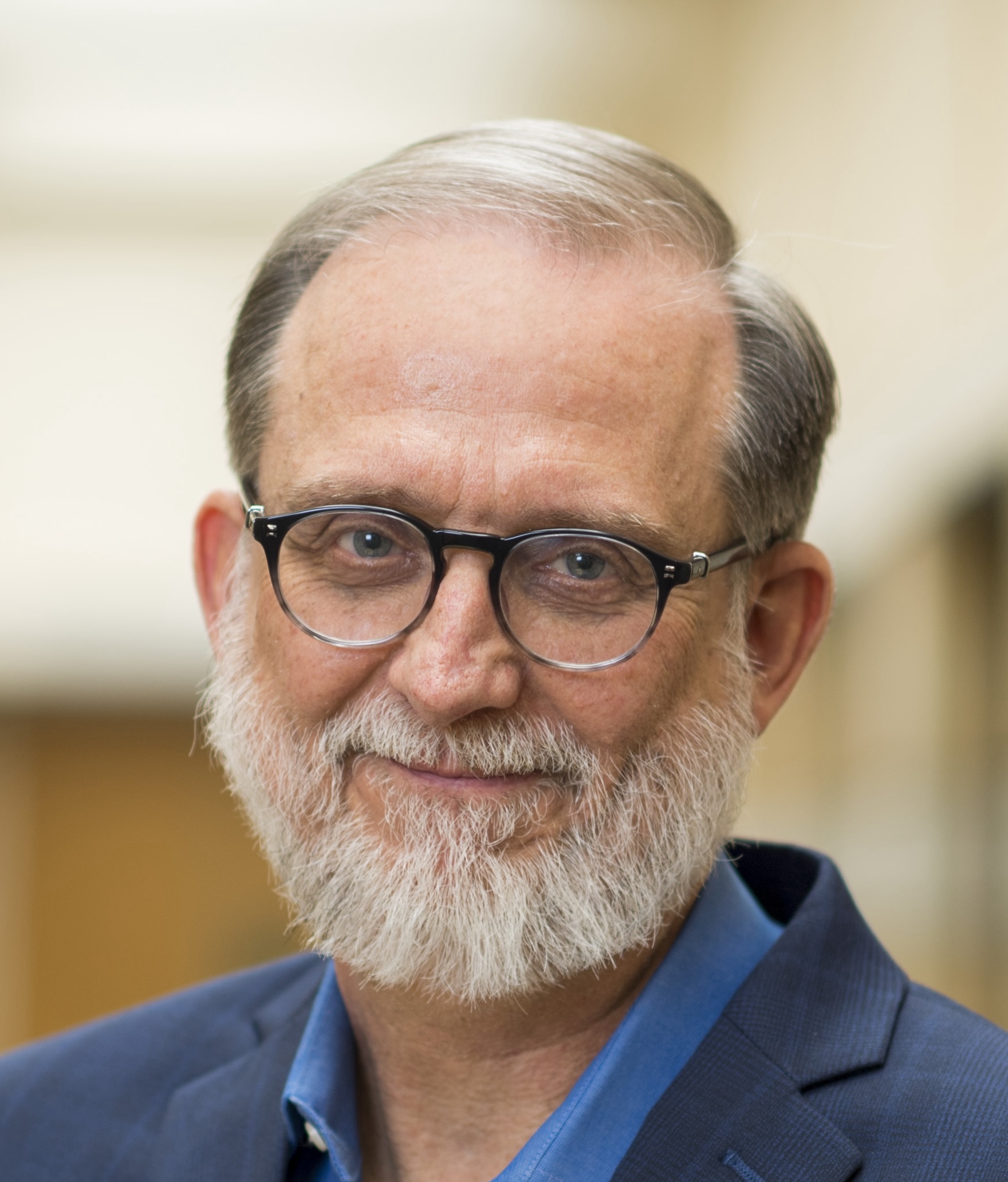
Almost everyone who studies religion, conflict, and peace has tried to understand Northern Ireland, so I was thrilled by the invitation from colleagues at the Kroc Institute for International Peace Studies and the Mitchell Institute for Global Peace, Security, and Justice to attend a workshop in Belfast.
I approached our shared task—to analyze “religious turbulence” and imagine “alternative futures”—as a historian of US religion associated with Peace Studies who has ancestors on both sides of the island’s troubled sectarian past. While more branches of my family tree include Catholics from the south, the Tweed branch descends from Protestants who were part of the seventeenth-century Scottish Plantation, settling on farmland in County Antrim and attending Presbyterian churches. While my direct ancestors left for America in 1848, during the Famine, those who stayed in the north went on to take sides during the Home-Rule debate, the Partition, and the Troubles. In other words, I have ancestral ties to the colonial past my Irish Catholic relatives lament and to the twentieth-century Troubles almost everyone laments, including those in my ancestor’s Presbyterian congregation who signed the 1974 “Witness for Peace” statement and who welcomed me warmly when I visited the day before the Belfast workshop.
I had not planned to visit those relatives or ponder my family history when I began preparing for our scholarly collaboration, but Northern Ireland religious leaders and US Peace Studies specialists reminded me that personal disclosures can help. Clergy in the north have recommended including “personal narrative in public discussions,” and Peace Studies specialists have said those hoping to cultivate the moral imagination required for “constructive social change in settings of deep-rooted conflict” must overcome the academic impulse to “eliminate the personal.”[1]
I tried to overcome that impulse as I considered what I might contribute as an outsider with distant ties to combatants on both sides of the sectarian conflict. I decided it might help if I took a step back and reflected on the most useful analytic frames, guiding metaphors, and interpretive terms for the analysis of religion and conflict in post-Brexit Northern Ireland. In particular, considering my research on the US and engaging scholarship about the island, I wondered how we might interpret both “specific trigger events” and “longer-term context,” or what others have called “short-term shocks” (Famine, Partition, and Brexit) and “long-term trends” (colonialism, urbanization, and industrialization)?[2] Almost all international, national, and local peacebuilding documents suggest islanders must confront the legacy of the past as they articulate a shared vision of the future, but polarization often sets in as soon as the stories start.
Maybe new frames, metaphors, and terms can help.
Frames, Metaphors, and Terms

Scholars who write about the island have made helpful proposals. Brendan Murtagh has compared post-partition Belfast to political zones like Cold War Berlin and the Korean DMZ and argued the city is best understood as a “border landscape.” Others describe post-Reformation Irish religious space as a “theological palimpsest” and chronicle how the devout have inscribed competing notions of religious authenticity and collective belonging on the landscape.[3] Some highlight residential and activity segregation, suggesting that Belfast’s distinct communities can be understood as “ethnic enclosures,” or, analyzing local perceptions, they note that the barriers, flags, and murals that mark bounded space produce “landscapes of menace” and “landscapes of exclusion” (see, for example, F. W. Boal and Madeline Leonard). An ecocritic imagined the “Eden of the future” by foregrounding Belfast’s river-systems and figuring the city as a “riparian zone,” a transition area between fully terrestrial and fully aquatic systems (see Katherine M. Huber on this point). That analogical language is suggestive since just as riparian zones are prone to flooding, Belfast’s landscape has been the site of periodic deluges of sectarian hostility, and, as Ciaran Carson suggested in Belfast Confetti, the Farset, the city’s hidden river, follows “the line of the Peace-Line, this thirty-foot-high wall of graffiticized corrugated iron” (49).
The Comparative Gaze
While these interpretive vocabularies illumine some aspects of the conflict, I think terminology from the natural sciences, especially niche theory and sustainability studies, might help to reframe the conversation about the island by highlighting lifeway transitions, eco-cultural niches, and sustainability crises. That’s the approach I take as I analyze the history of religion in the lands that became America, where religion both escalated and eased crises of sustainability.[4] It inspired both status-reinforcing devotion and popular revitalization movements in stressed cornfield cultures between 1100 and 1350, when weather changed, crops failed, devotees clashed, and violence spiked. During the colonial exchange of biota, competing religious empires triggered demographic decimation, environmental stress, social inequality, and psychic trauma between 1565 and 1776 as settlers displaced Native Peoples and introduced the slave plantation. An urban industrial crisis intensified between 1873 and 1920, when fossil-fuel dependency increased pollution, and income inequality and health disparity in crowded northern cities signaled a wider decline in well-being. The global environmental effects of industrialization and urbanization peaked during the 1950s “Great Acceleration,” the onset of the time when human intervention in natural systems became predominant. The abrupt rise in carbon dioxide, methane, and ice-bound nitrates in polar ice levels signaled significant and long-term global ecological damage. That damage, in turn, threatened dramatic social and economic disruptions, from climate migrations to food scarcity, and presented new challenges to religious communities, which struggled to respond to deepening economic inequalities and mounting cultural polarization.
Descendants of the thirteenth-century cornfield cultures eventually confronted their difficulties, but the unresolved Colonial and Industrial Era crises were passed on to future generations. Americans now face the legacy of those social problems, including racial and economic inequality, while they also confront the unprecedented challenges of a global environmental crisis.
Reimagining the Island’s Past and Future
Can this framework help to reimagine the island of Ireland’s past as a series of resolved and unresolved sustainability crises? There was a medieval crisis as the climate-induced Great Famine (1315-1322) and the microorganism-caused Black Death (1347-1351) stressed farming and grazing niches in the fourteenth century. Were there lasting legacies of those crises that would shape the later sectarian conflict? Can we talk about a colonial crisis on the island? If so, when did it start and end? Was there a colonial exchange of biota, and a breaking of ancestral traditions, including spiritual practices focused on sacred sites, as with the veneration at holy wells? How did the displaced reimagine pilgrimage and recreate devotion in the new stressed niche? Was there an inequitable planation niche, as there was in the US South, and was it sacralized by a form of planter piety? If so, how did local revitalization movements use spiritual resources to challenge it? Specialists (for example here and here) have highlighted industrial Belfast, but does it also help to talk about an industrial crisis on the island, or at least in its northeastern corner, between about 1870 and 1920? Simon Purdue has documented ecological degradation in urban Belfast and demonstrated a decline in well-being, economic stability, and food security among mill workers. Most relevant for understanding the later conflict, Industrial Era employers constructed housing that would become the scene of post-1969 sectarian conflict, as Colm Heatley has argued.[5] During the Troubles, fatalities occurred disproportionately in the poorer, religiously segregated, working-class neighborhoods that had formed as grimy industrial niches. To what extent, then, can we see later religious conflict as the product of an unresolved colonial crisis and the legacy of an unresolved industrial crisis?

Does this analytic frame and interpretive vocabulary help? I’m not sure. But using sustainability and well-being has practical advantages because those terms have informed local and global thinking about possible futures. Similar language appears, for instance, not just in the UN Sustainable Development Goals but in The Belfast Agenda, the City Council’s vision for 2035. As I learned when I tried out the idea with my relatives in that North Antrim congregation, reframing those aims as the conditions for transgenerational sustainability and avoiding any mention of Protestant unionists and Catholic nationalists might open some participants to reimagining the troubled past as a series of shared sustainability crises and to envisioning future-focused deliberations as collective efforts to repair Belfast’s socially and ecologically stressed eco-cultural niche.
[1] John Paul Lederach, The Moral Imagination: The Art and Soul of Building Peace, viii–ix; quoted in Gladys Ganiel, “Pulpit to Public: Church Leaders on a Post-Brexit Island,” 574. The Corrymeela report she describes includes recommendations which emphasize “personal narratives.” See Corrymeela, Crossing Borders: Brexit and the Book of Ruth, 6.
[2] John Wolffe, “Conclusion: Beyond Protestant-Catholic Conflict?” in Protestant-Catholic Conflict from the Reformation to the Twenty-First Century: The Dynamics of Religious Difference, 251–64. Ian N. Gregory, et al., Troubled Geographies: A Spatial History of Religion and Society in Ireland, 9.
[3] Anna Gritching, “Introduction: Social Ecologies and Borderlands,” in The Social Ecology of Border Landscapes, 2, 5, 9; Gregory, et al., Troubled Geographies, 1.
[4] Thomas A. Tweed, Religion in the Lands That Became America: From the Ice Age to the Information Age (New Haven: Yale University Press, forthcoming).
[5] Colm Heatley, Interface Flashpoints in Northern Ireland , 81.

